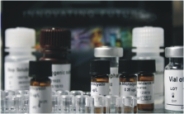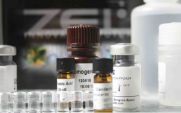



Toxin analysis
 |
MICROCYSTEST KIT - Detection of microcystins in drinking and recreational waterMicrocystins are a group of hepatotoxins produced by cyanobacteria during and after blooms in water bodies. Consumption of contaminated water with these toxins can promote cancer. The toxicity of microcystins is associated with the inhibition of protein phosphatases 1 and 2A enzymes (PP1 &PP2A), which leads to hepatocyte dysfunction. MicroCystest is the first and only commercially available kit based on the inhibition of the PP2A activity by microcystins, and therefore able to detect all potential toxic microcystins present in the sample (over 120 different varieties of MCs have been described up-to-date). Monitoring of drinking and environmental water is therefore very important; and so a provisional upper limit of 1 µg/L in drinking water was introduced by the World Health Organization as a guideline. MicroCystest kit uses this inhibitory reaction for determination of microcystins concentration by means of a microtiter plate and a colorimetric substrate. The enzyme hydrolyses the substrate and the product can be determined by an absorbance measurement at 405 nm. As the ability of the PP to hydrolyse the substrate depends on the presence of microcystins in the samples, the toxin concentration can be calculated by using a standard curve. The U.S. Environmental Protection Agency (EPA) has verified the performance of MicroCystest kit for detection of microcystins under the Environmental Verification Technology Program (ETV).
|
 |
Benzo[a]pyrene (BAP) ELISA Test KitThis test kit provides a competitive enzyme immunoassay for the quantitative analysis of Benzo[a]pyrene in water, vegetable oil, fish, shrimp and meat . The unique features of the kit are: - High recovery (>75%), Rapid and cost-effective extraction methods for various samples. - High sensitivity (0.25ng/g or ppb) - A quick ELISA assay (less than 2 hours regardless of number of samples). - High reproducibility. - Cross reactivity: Benzo[a]pyrene =100, Hexachlorobenzene <0.1, Hexachlorocyclopentadine < 0.1, Methoxychlor < 0.1
|
 |
Aflatoxin B1 ELISA Test KitIt is a competitive enzyme immunoassay for the quantitative analysis of Aflatoxin B1 in cereals, feed, milk ,oils, peanuts .The unique features of the kit are: - High recovery (75-125%), rapid (10-40minutes), cost-effective extraction methods. - High sensitivity: 0.1 ng/g in milk, 1.25 ng/g in dried meat, fish, cereal, seed, 0.5 ng/g in vegetable, peanut, olive oil - High reproducibility. - A quick ELISA assay (only 1 hour regardless of number of samples).
|
 |
Total Aflatoxin Measurement KitTotal Aflatoxin ELISA Test Kit is a competitive enzyme immunoassay for the quantitative analysis of Total Aflatoxin (B1, B2, G1, G2) in cereals, meat/fish, feed, milk ,oils,peanuts and pistachios . The unique features of the kit are: - High recovery (80-105%), cost-effective extraction methods. - High sensitivity (0.05 ng/g or ppb). - High reproducibility. - Quick (less than 2 hours regardless of number of samples). Procedure Overview The method is based on a competitive colorimetric ELISA assay. The toxin of interest has been coated in the plate wells. During the analysis, sample is added along with the primary antibody specific for the target toxin. If the target is present in the sample, it will compete for the antibody, thereby preventing the antibody from binding to the toxin attached to the well. The second antibody, tagged with a peroxidase enzyme, targets the primary antibody that is complexed to the toxin coated on the plate wells. The resulting color intensity, after addition of substrate, has an inverse relationship with the target concentration in the sample. Content of the kit 1 x 96 wells microplate (42measurement in duplicate, from which 12 are used for the standards) with Aflatoxin coating. Aflatoxin standard with different concentrations (0.05 to 0.8 ng/ml) Antibody 1 and Conjugate Antibody 2, wasching solution, substrate for the enzymtic reaction, stop buffer Return any unused microwells to the foil bag and reseal them with the desiccant provided in the original package. Store the kit at 2-8°C. The shelf life is 12 months when the kit is properly stored.
|
 |
Detection of okadaic acid and derivates in bivalve molluscs, OKATESTHuman consumption of shellfish contaminated with OA-toxins group (OA, DTX1, DTX2 and its esters) causes Diarrheic Shellfish Poisoning (DSP). Inhibition of serine/threonine protein phosphatases (PP1 & PP2A) activity by this group of toxins is assumed to be responsible for these diarrheic disorders.This test is a ready-to-use colorimetric phosphatase inhibition assay for quantification of OA-toxins. OkaTest is performed in a 96-well microtiter plate and is applicable to shellfish such as mussels, clams, oysters and scallops. OkaTest complies with the legislation requirements for quantitative determination of OA-toxins in molluscs. It complies with the criteria stipulated by the European Reference Laboratory on Marine Toxins and Commission Regulation 15/2012 for determination of OA-group toxins in molluscs, according to the European Commission (DG-SANCO) Advantages:
|
 |
Trofopast Biomedix Herbicides PanoptisBiochemical Assay for the Determination of herbicides, including Glyphosate in Water, Food, Vegetables, Fruits, Human fluids Samples The introduction of genetically modified crops resistant to Glyphosate (i.e. Roundup Ready®) has caused an increased use of Glyphosate, allowing farmers to control weeds without harming their crops. The emergence of Glyphosate-resistant weeds has also caused increases in frequency and volume of applications of Glyphosate in combination with other herbicides. Due to its widespread use, Glyphosate has become ubiquitous in the environment and food supply. Glyphosate can adsorb to soil and is highly water soluble, which can cause surface and ground water contamination from run- off, soil erosion, and leaching especially after heavy rainfall. The long-term impact on the environment and human health are growing concerns. In March 2015, the World Heath Organization's International Agency for Research on Cancer classified Glyphosate as "probably carcinogenic in humans" (category 2A). Some studies show a correlation between exposure to Glyphosate-based herbicides and non-Hodgkin's Lymphoma in humans and others show evidence of Glyphosate causing cancers in laboratory animals. In the European Union, the combined maximum residue level (MRL) for Glyphosate and its relevant metabolites in drinking water is 0.1 ng/mL. Test sensitivity: The Trofopast Biomedix Herbicides Panoptis has an estimated detection limit (90% B/B0) of 0.05 ppb (ug/L). The middle of the test (50% B/B0) is approximately 0.5 ppb. Determinations closer to the middle of the calibration curve give the most accurate results.
|
Stavicheck Thermal Foodit is a rapid test for determination of acid phosphatase activity. It an detect of surfaces or foods maintain a potentially hazardous uncooked pathogenics. It can be used directly on raw meat residues. It is a quatitative method. range of detection: 0-50 % of raw meat residue, 0-2428 RLU (relative light unit) shelf life: 24 months at 2-8 °C
|
Oberdorfstrasse 51
CH 3930 Eyholz
tel + 41 27 946 80 18
fax + 41 27 946 86 42
info@sysmatec.ch

